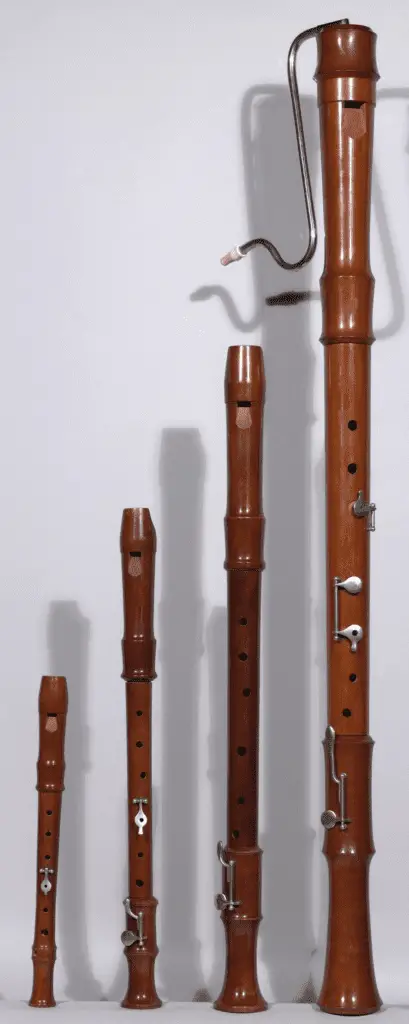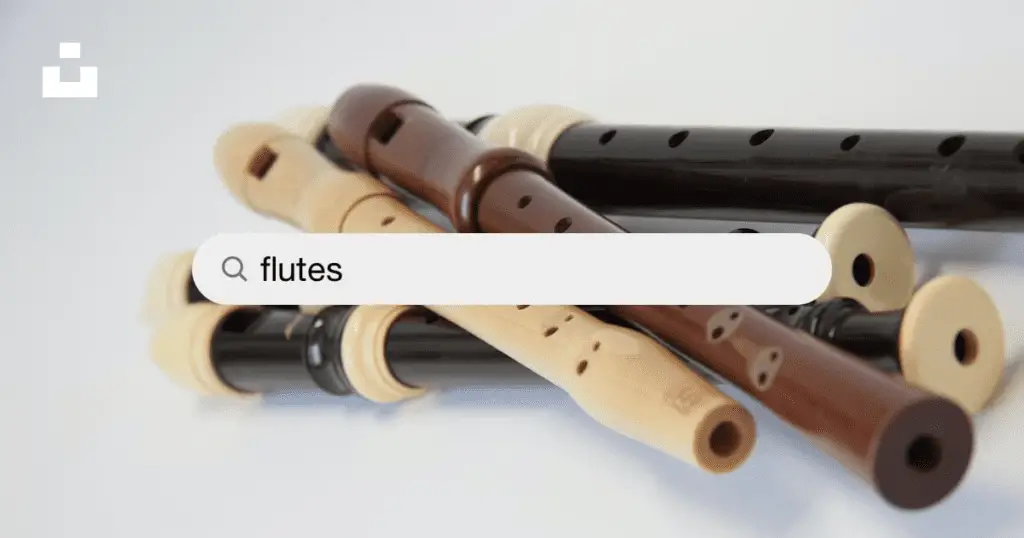The notes on the flutes and recorders are almost but with slight differences because the flute plays higher and lower notes than the recorder. Flute instruments are quite old and have long been in use. In prehistoric times, flute instruments were made from hollow bones and played with one or both hands. The modern pan flute, which consists of individual bamboo or bone tubes, is also a flute-like instrument. In prehistoric times, recorder-like instruments were also used.
See also: Are Flute and Piccolo Notes the Same?
Familiarity
Although the flute and the recorder share a common history, they have evolved into two different instruments. The flute is a transverse instrument with the player blowing over it while the recorder is played vertically with both hands placed in front of the upper body. Both instruments belong to the fipple family, which includes the Native American flute and the penny whistle. Flute players develop a technique called transverse fingering, while recorder players focus on straight fingering.
The recorder is a popular woodwind instrument that shares its derivation with the flute and saxophone. It has a long and distinguished history, dating back to 900 BC. The instrument was used in the Renaissance and Baroque periods, where it gained popularity. It was also used by composers like Purcell, Handel, and Johann Sebastian Bach.
The recorder was originally made from bamboo. Its predecessors had six fingers with a thumbhole, so the instrument needed to be modified to accommodate its new fingerings. Several workshops began to offer recorders with three to six semitones after the 1930s. They also sought to make instruments with more familiar keys for beginners, including Germans Max Huller and Ludwig Schlosser.
The problem of condensation on the instrument has plagued recorder makers for centuries. Many French and English flageolets contain a sponge that absorbs moisture, creating resistance when the player tries to breathe into the instrument. However, many 19th-century csakan makers came up with novel solutions. One was the introduction of a thin wooden wedge into the windway. Another method involved drilling two small holes into the side of the instrument.
While there are a few differences between the flute and recorder notes, the basic principles are the same. While flutes are larger than the recorder, they use different fingering systems to produce the correct sounds. For example, the E-flat cornet is an example of an E-flat flute. Similarly, a D-flat band flute sounds like D-flat when played in a C-flat key. While the logic behind these two methods is similar, the differences between the instruments are more a matter of tradition than logic.
One of the best ways to develop a thorough knowledge of recorder notes is by learning some of the most popular Christmas songs. For example, Franz Xaver Gruber’s “Christmas Carol” has become a favorite Christmas song all around the world. As a beginner’s song, this is a perfect choice, as it uses both 3 /4 timing and good fundamental techniques. It’s also a bit longer than other materials, but this will stretch your abilities.
See also: Are Flute and Piano Notes the Same?

Range
The flute and recorder share the same range of notes, with a few important differences. The first of these differences is the scale of the instrument. Both instruments have a fixed range of notes, but a flute’s range is significantly wider than a recorder’s. A recorder’s range is about a third the size of a flute. A flute’s range of notes is about four octaves.
The range of flute and recorder notes is a major and minor third higher than the pianos. A recording may have been written in a single note, or it may be divided into several sections for several performers. During the Baroque era, recorder parts were usually notated in the treble clef, but they may also be written in the French violin clef.
In the 16th century, a set of fingerings for a hybrid instrument was published. This included a set of notes for the 15th harmonic, which was a variant of the 14th. Sebastian Virdung published Musica getutscht in Basel, while Martin Agricola published Musica instrumentalis deudsch in Saxony.
See also: How Are Flute and Clarinet Similar?
When you’re choosing a flute, look for the range of notes in the key you wish to play. The G flute is the most common, though you may also find flutes in other keys. A lower-pitched flute may appeal to beginners, but you should also be sure to choose a flute with six holes to avoid any pitfalls.
A recorder’s range is approximately two octaves higher than the flute’s, with a soprano recorder’s range ranging from middle C to D above the staff. The alto recorder has a range of notes between F and G and uses all five fingers.
The range of flute and recorder notes varies. Flutes use the same written fingerings, while recorders use different fingerings. The lowest note on a tenor and soprano recorder is C, while the lowest note on a bass recorder is F.
Flutes are often found in jazz and folk music but have recently become popular in pop music. For example, American pop singer Lizzo frequently plays the flute in her concerts. Modern composers tend to use extended techniques for the flute, such as open holes and Boehm’s fingering system. Historically, the flute and recorder were mostly played in Consorts or ensembles. However, the recorder was also played as a solo instrument during the Baroque.
Fingering systems
Fingering systems for flute and recorder have evolved over the years, and some are better suited for some instruments than others. The Peter Harlan fingering system, first developed in the early twentieth century, was mainly used on school recorders in German-speaking countries. Its major advantage is that it makes the fourth step playable without the use of forked fingering. However, it also has a number of disadvantages, including the fact that it makes some notes unplayable. As such, it is no longer widely used on better-quality recorders and is not a preferred technique by professional musicians.
Fingering systems for the flute and recorder vary depending on the size of the instrument. The size of a recorder also affects the pattern of fingering and the names of the notes. It is best to use the fingering system that is best suited to the instrument. Recorders that are made with a German fingering system are often manufactured without double holes and multiple fingerings.
The recorder is the first instrument to change the fingering system. The instrument’s shape is similar to that of a flute, but its tone holes are much closer together. As a result, recorder players must have perfect hand positions. In addition to this, some recorders have open holes, while others have keys.
While the choice between fingering systems for the flute and recorder is up to the player, the fingering system should not be the only consideration. It should be remembered that the recorder’s sound is also dependent on the style of the instrument, so it is not always possible to play both instruments using the same fingering system.
The fingers of the flute and recorder differ, and both instruments should be played in a way that is comfortable and efficient. In order to play the flute properly, the player must have great control over the respiratory system. For this reason, it is advisable to choose a transverse fingering system.
Modern fingering is the most common system for recorders today. It is used on virtually all contemporary instruments, with few exceptions for student instruments. German fingering is not as common and is only used for a small number of instruments. Most custom makers report that a majority of the orders they receive for reproduction baroque recorders are for modern fingering.

Price
Flute and recorder notes come in different prices depending on their quality and craftsmanship. Traditional instruments are made of wood and can cost $30 to $100, while more expensive instruments can run into the thousands. Lower-priced instruments are made in factories, while higher-end instruments are hand-crafted by skilled craftsmen. The quality of sound also varies by individual taste.
Both flute and recorder notes can be purchased online, and most stores offer both at competitive prices. Depending on the type of music you plan to play, you can save a lot of money by shopping around. If you are looking for the best value, you may choose to purchase a handcrafted flute from a specialist. The price of a good instrument can range from $500 to $1000, but you can also buy used flutes that are less than half that cost. But beware of cheap flutes – they don’t usually last as long as the good quality flutes do.
If you’re looking for a cheaper instrument, you can consider a low-end model made of maple. This type of instrument has a thin body, which is important if you want to be able to make sustained notes. A higher-end model with high-quality materials is also worth considering. A high-end model may have a thicker body to resist wear.
While they both share a common history, the flute and recorder have evolved into separate instruments. Flutes are used in orchestras and recorder playing is often restricted to folk and chamber music. Both instruments have an extensive repertoire, but flutes have more solos and chamber pieces than the recorder.
Flutes and recorders are similar in appearance, although they differ in tone. While flutes have more tone holes, recorders have a more resonant tone. A recorder has six to eight-tone holes compared to a flute with thirteen to seventeen. Recorders are also easier to play. The difference in tone and fingering is the main difference between the two instruments. The flute is played horizontally while the recorder has a conical bell.
